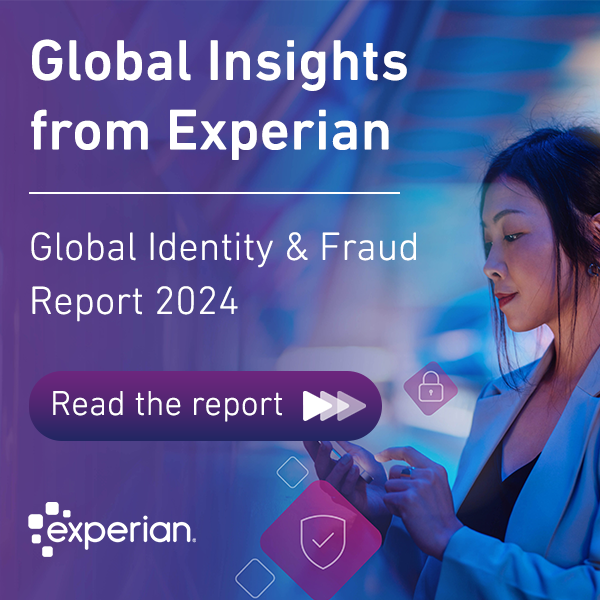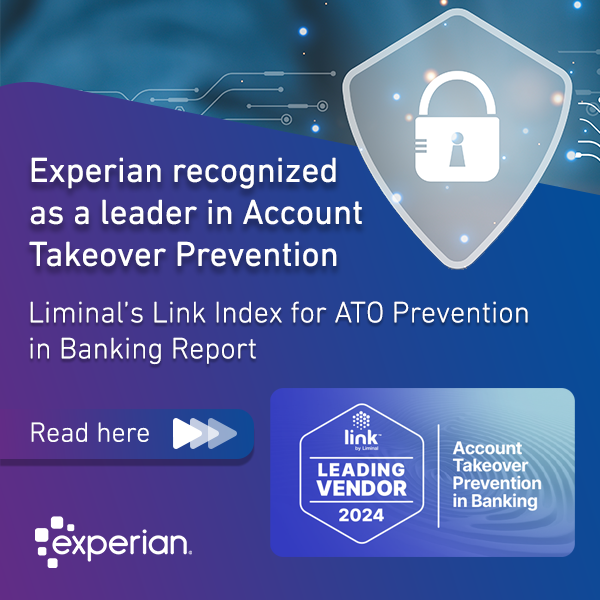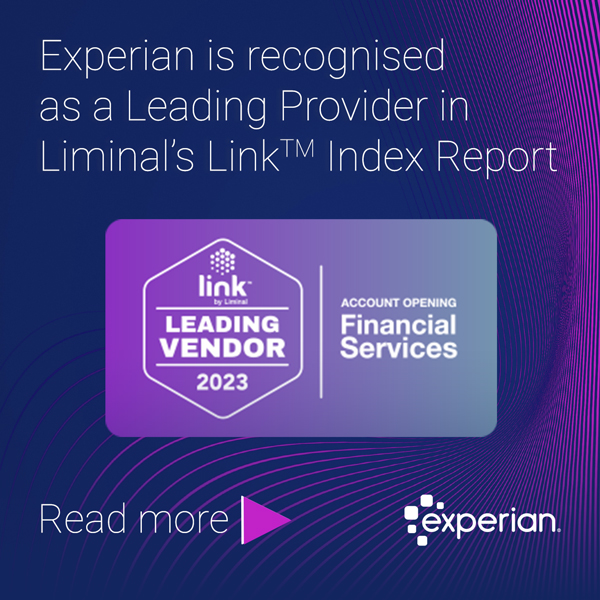Tag: Digital Transformation

Consumer demand has shaped the way businesses worldwide have adjusted or intend to adjust operations and investments throughout the pandemic. Businesses that have struggled to meet the new expectations of consumers will need to meet ever-changing conditions with careful investment and data-driven analyses. Experian’s latest Global Insights Report shows two-thirds of consumers globally have remained loyal to their favorite brands during the pandemic. Brand loyalty was found to be the highest in India, at 80%, and lowest in France, with a bit more than half, at 57%. However, loyalty may not be a given going forward. Competitive differentiation is founded on how you engage customers, at every interaction. Our research shows that loyalty is intrinsically linked to trust, security and convenience. Payment system providers, such as PayPal, have retained the top spot for customer loyalty for three years in a row, but there continues to be movement among the remaining top five industries. This fluctuation, indicative of consumer preferences and behaviors, is fueled by the varying speed at which businesses globally are transforming front- and back-end systems. Particularly, this holds true for the pace of digitization of credit risk and fraud risk operations. Leverage data to retain loyalty Consumers have higher expectations than ever before, and businesses need to meet or exceed these expectations by adapting to correlate with the dynamic nature of the customer journey throughout the continuing pandemic. The report also found that 60% of people have higher expectations of their digital experience than before Covid-19, increasing the need for businesses to make sure that they are leveraging data to benefit their customers, providing secure and convenient digital experiences. Although most customers have shifted to digital and prefer the conveniences of online, mobile and contactless transactions, concerns over data security remain. In response, businesses need to carefully navigate customer experiences to ease apprehension. A great example is the trust, and therefore loyalty, that can be established by using customer data for identity authentication. Customers gain protection while enjoying a hassle-free experience that is non-threatening and transparent. Some businesses recognize these needs, with 40% reporting they are doing a better job communicating how customer data is used to enhance the customer experience, protect consumer information and personalize products and services. Integrating data, analytics and technology Our survey also found that only 24% of businesses are deliberately making changes to their digital customer journey. However, many of them have intentions of making changes and are increasing their budgets in order to do so. Three of the top five solutions businesses are using to help improve the customer journey are designed for driving insights into faster customer decisions. Of these top five solutions, the use of AI to improve customer decisions ranks first amongst banks, payment providers, and retailers ranks first. Companies who are, or plan to, accelerate the implementation of AI can make faster, smarter data-driven decisions to better serve consumers. The key to better serving customers lies in a business’s ability to integrate data and decisioning technology to deliver fast and relevant products and services. In fact, the study found that one in three consumers are only willing to wait 30 seconds or less before abandoning an online transaction, including accessing their bank accounts. With such a short window to keep the customer engaged, faster decision making is imperative to not only retaining a customer’s loyalty on a long-term basis but getting them to commit to a transaction once. Businesses, particularly retailers and financial services who implement the necessary technologies will help move economies from sustainability mode towards a future of growth but cannot do so without continued consumer demand. While customer loyalty does remain, it is up to businesses to adapt and accommodate to retain, and potentially increase the impact of these adjustments. Regardless of where they’re transacting, consumers expect a secure, convenient experience—and they’ll quickly abandon transactions if they’re let down. So, businesses must keep their focus on transformation. Discover more insights from our longitudinal study of the impact of Covid-19 on businesses and consumers.

In the not so distant past, consumers mostly interacted with their banks in person. Retail customers, for instance, waited in line to make a deposit or talk to a banker. And though the branch may have been busy, a moving line gave comfort to customers that the wait wouldn't be much longer. However, customer expectations in the digital era are dramatically different. According to Experian's new research, one in three customers will abandon a transaction if they have to wait more than 30 seconds, especially when accessing bank accounts. And that's just the tip of the iceberg. When it comes to the digital experience, consumers increasingly want seamless service at every point of their journey. Now, as the Covid-19 crisis continues to accelerate digital demand, financial institutions face more and more customers with similar if not greater expectations. Expectations for things like personalized products, contextual lending decisions, and offline-online seamlessness. And those organizations that understand these evolving needs and deploy cloud-based decision management to ensure they meet them will likely be the winners in this new world. Right here, right now Banking digital transformation was already underway before the pandemic began. Most retail banks provided some customer-facing app. In efforts to automate and streamline business processes, many organizations have also started to migrate their backend infrastructure from on-premise software to the cloud. The pandemic, though, ramped up the demand for everything digital seemingly overnight. Consider that consumer adoption of mobile wallets has jumped 11% since July, largely due to increased contactless in-payments. In the height of the crisis, customers turned to online platforms for financial assistance, from federal loans and grants to mortgage relief and credit applications to small business loans. Businesses that had already migrated to cloud-based solutions were able to scale their response to meet that growth. But that those hadn't? They faced the combined challenge of needing to scale existing services to serve the influx of online customers while simultaneously adding new digital capabilities. As a result, some organizations have ended up playing catch up with their digital offerings. Experian research shows, though, that it's a race worth finishing. Sixty percent of customers say they have higher expectations of their digital experience now than they did before the pandemic. To be sure, the crisis will end. Those expectations, however, are here to stay. A glimpse of the future Banks may see fewer customers in person, but that doesn't mean their service can't be personal. The data analytics features of cloud-based decision management software allow businesses to know more about their customers, providing personalized offers and services right when customers need them most. One bank we work with in India provides an ideal example. They've leveraged deep analytics and decisioning solutions to accelerate their online loan approval process from days down to seconds. They're no longer turning people away who are good candidates for loans. And they've increased their lending without having to take on additional risk. It's a win-win that reveals how organizations can leverage technology to satisfy customer expectations during the height of a crisis and continue to in a post-Covid reality. With cloud-based solutions, organizations can become 100% customer-centric, both in convenience and personalization. The data gives financial institutions a holistic view of their customers, enabling them to anticipate needs and tailor solutions to the individual. Transformation and soon No organization is going to digitally transform overnight. But given the urgency of the demand, there are proven ways to improve their digital customer experience sooner rather than later. Small-to-mid-sized organizations, for instance, should consider out-of-the-box Software-as-a-Service (SaaS) solutions. These offer pre-determined, high-demand use cases such as online eligibility checks and customer acquisition tools. Organizations can modify these solutions to meet specific market needs while saving time on ramping up a fully custom solution. Additionally, even with the imperative to meet the digital demand, it's important to remember that proper planning leads to successful cloud migrations. Consider all the possibilities of what could go wrong and right in terms of incident management, customer service, links to data sources, and more. Rehearse your transition as much as feasible. The preparation may add a bit of time on the front end, but you'll decrease the likelihood of significant disruption when you do migrate and that's worth the effort. The march toward an increasingly digital customer experience only moves in one direction: forward. The pandemic may have pushed financial institutions to speed up their transition to cloud-based decision management, perhaps a bit earlier than some anticipated. But the outcome of a proactive, data-driven organization centered on serving customers promises to be better for everyone. Related stories: New research available: The continued impact of Covid-19 on consumer behaviors and business strategies Automating fairness: Using analytics to help consumers in a pandemic era In digital transformation, small wins lead to big outcomes

As the world faces another resurgence of the coronavirus, businesses will again be tested on their response—but this time consumer expectations will be much higher. In the beginning of the pandemic, businesses scrambled to set up remote workforces and new ways to support customers as everything locked down. In the short-term, many consumers stayed loyal to businesses they frequented before Covid-19. However, our recent research shows that loyalty may not be a given going forward. Download Global Insights Report – September/October edition Key insights: 1 out of 3 consumers is only willing to wait up to 30 seconds before abandoning an online transaction, especially when accessing their bank accounts. Half of the businesses surveyed have either mostly or completely resumed operations since Covid-19 began but only 24% are deliberately making changes to their digital customer journey. 60% of people have higher expectations of their digital experience than before Covid-19. In mid-September 2020, we surveyed 3,000 consumers and 900 businesses in 10 countries, including Australia, Brazil, France, Germany, India, Japan, Singapore, Spain, the United Kingdom, and the United States. This report is the second of three in a longitudinal study exploring the major shifts in consumer behavior and business strategy pre- and post-Covid-19. Our first report in the sequence, published in July/August, can be found here: Global Insights Report – July/August edition. Though businesses worldwide have started to see their operations stabilize, moving from survival mode toward sustainability, growth still presents a challenge. High expectations for security and convenience compounded by the increased demand for online payments, banking and shopping are pushing businesses to re-imagine the customer journey—and the investments they make to drive future growth. Top 5 initiatives amongst banks, payments, and retailers that have been accelerated by Covid-19: Use of AI to improve customer decisions Strengthening the security of mobile and digital channels Increasing digital acquisition and improving engagement Automating customer decisions Understanding customer profiles (e.g. affordability, preferences, behaviors) Most consumers reported a positive experience in their sudden shift to the digital channel and plan to increase their online transactions. The pandemic has also accelerated the move toward contactless payments for when shopping in-person is essential. The result has been a merging of consumers’ online and offline worlds calling upon businesses to create a fluidity between cross-channel interactions. 61% of people surveyed now regularly order groceries or food delivery online. This is a 7-point increase in this type of online payment since July. Adoption of mobile wallets has jumped +11% since July as consumers continue to increase their online activities and contactless in-person transactions. 70% of businesses have a plan to move customers out of Covid-induced collections but the implications of that impact on the balance sheet and future provisions are not yet clear. Regardless of where they’re transacting, consumers expect a secure, convenient experience—and they’ll quickly abandon financial transactions if they’re let down. Are businesses adapting the customer journey as quickly as customers are expecting more from their digital experience? Keeping up with consumer expectations: 77% of people said they feel most secure when using physical biometrics, and 62% of people said it improves their customer experience when managing finances or payments online. Consumers are most concerned about protecting their financial data over other types of information (e.g. personal, contact, web history). The concern is highest in France (46%) and Japan (43%). For the past 3 years, consumers trust payment system providers (e.g. PayPal, WePay, Apply Pay) the most for consistently providing a secure and convenient digital customer experience. Find out what top 3 solutions businesses are using to help improve the customer journey.

Public and private organizations worldwide are embarking on ambitious digital identity initiatives, from the tiny country of Estonia to efforts that encompass much of Africa and India. At the core, the broad goal is often the same: Use blockchain or equivalent technology to provide individuals with a unique digital identifier. That digital identity then enables seamless, secure access to services—governmental, financial, or otherwise. However, as you delve into the details of each program, there remain more differences than similarities. Organizations may have different drivers for pursuing digital identities and varied approaches. And in these early days of digital identity development, there’s not yet a single plan for aligning initiatives across the public and private sector or even within the financial services industry. So how do organizations evaluate where to invest and when to act, when efforts are progressing and changing in real-time? The impetus now is to understand the fundamentals of digital identity programs and then evaluate what your organization stands to gain—or potentially lose. Get that sorted, and you’ll be ready to make smart digital identity decisions at the right time for your company and customers. The fundamentals of blockchain Much of the digital identity conversation centers around the notion of blockchain-based digital identity programs and their benefits to consumers or citizens. Broadly, these programs enable individuals to have a digital identity profile, which is tied to a basket of attributes and stored on a blockchain. Those attributes are verified when the identity is established. Consumers then use their digital ID, for example, to access their financial applications. And organizations can verify the person via their digital identity token. Such programs provide privacy for consumers; they also promise to accelerate and secure all sorts of processes from applying for loans to paying taxes. That’s because, with a digital identity, consumers don’t need to re-submit documents or provide personal information to various businesses and entities. Instead, they can allow institutions to access their digital identity for proof of who they are. The potential for such programs is already exciting, and we’ve likely just scratched the surface of what’s possible. Still, most of the discussions leave out a critical component. That is: how will programs establish a digital identity in the first place? As financial institutions assess the digital identity landscape, digging into how programs ensure that the right information makes it into the system is paramount. As the saying goes, it’s garbage in, garbage out. Regardless of how innovative the technology is, a consumer’s digital identity is only as trustworthy as the information that created it. The digital identity trade-offs The security of digital identities is very compelling—especially as cybercriminals become increasingly sophisticated. Businesses can easily authenticate customers, and consumers have more control over their information, which is an issue of growing importance. A recently released Experian study shows that consumers are most concerned about protecting their financial data over other types of information. As privacy and security assurances become part of the financial service value proposition, digital identity programs will likely be a differentiator for companies. That said, doubling down on digital identity can initially seem at odds with another dual technology priority: Taking advantage of data to provide hyper-personalized financial products and services. By tokenizing identity information, organizations may need to forgo some of the data that enables that personal, customized approach. In the long run, I believe companies will find creative ways to balance privacy with personalization needs. For instance, customers may rely on digital identities to navigate their financial networks and then opt to provide additional information about themselves in return for better, more personalized service. Financial institutions will need to weigh some similar factors when leveraging digital identity programs to improve customer experience. Digital identity programs promise to remove the friction caused by customer recognition and authentication. Again, the organization may give up some data collection to enable that seamless experience. But in the long run, companies will likely find that the related improvements and revenue opportunities gained more than makeup for any sacrificed information. At the same time, against a backdrop of an increasing number of stolen identity records, the idea that a digital identity program can help reduce the excessive proliferation of sensitive personal data is a significant benefit. The road ahead Financial institutions should prepare for the pending digital identity journey—even if they haven’t yet embarked. There are still multiple issues that the industry, consumers, and regulators will have to settle. For instance, there’s the question of adoption and how long it will take for businesses and consumers to use digital identity programs regularly. As we’ve discussed before, consumer trust and availability will remain a considerable component in driving that adoption. What’s more, we’ll likely see regulations follow digital identity efforts as specific initiatives gain steam and popularity. The rules may accelerate adoption or, conversely, increase the investment expense on behalf of financial service firms. For these reasons, financial institutions need to be involved early and voice their concerns often to ensure that regulations serve consumers without adversely affecting the business. In the meantime, businesses should remain aware that digital identity is a fragmented market, which may ultimately settle into an “ecosystem of ecosystems” across programs. It will be critical for enterprises to plan accordingly if they want to become early adopters. Or, at the very least, companies with a more moderate strategy should wait until a leading program emerges before making a significant investment. Digital identities represent a dramatic shift in how consumers navigate their online world and how companies continue to meet their online expectations and needs. Keep these developments on your radar, and you’ll be prepared to make smart digital identity decisions and investments. Related stories: Infographic: Global Identity & Fraud Trends, February 2020 The impact of Covid-19 on Consumers and Businesses, July 2020 The impact of Covid-19 on Consumers and Businesses, Oct 2020

For executives and teams across the financial services sector, the question isn't should we digitally transform—but how. That's where things get tricky. According to the Financial Brand’s Digital Banking Report, when asked about the progress of their digital transformation journey, only 17% of organizations reported that their transformation was deployed “at scale” — and a scant 7% said their transformation was deployed at scale and working. Tackling an enterprise-wide transformation effort is no small feat; it requires significant investment and time. Still, many organizations become understandably discouraged when transformation efforts don't yield the anticipated results. And experts contend that transformation initiatives fail not because of products but because organizations need wholesale culture changes to sustain innovation. All that may be true. However, a boil the ocean approach can dramatically increase the timeline of an already lengthy process. By building a strategy based on small iterative wins, businesses can break down the process and deliver interim tangible successes. In doing so, organizations sustain momentum for the broader digital transformation vision and benefit from feedback along the way. Your north star In concept, digital transformation suggests that we are in a finite time and place going from point A to point B. At some point, every financial institution will be digitally transformed. Manual processes, on-premise software, and siloed data will start to disappear. And conversations about transformation will give way to discussions of how to sustain and further advance the bank's digital capabilities. There actually isn’t a “finished state”, but a continuous progress towards a better customer experience. But establishing a long-term objective for transformation initiatives is critical. The leadership team needs to have a vision, and relay the overall goal to the rest of the organization. For instance, in the Financial Brand survey, banks and credit unions noted that improving risk management and security, improving the customer experience, and reducing costs were their top areas of focus. (Unfortunately, the same study revealed that less than half of the organizations surveyed reported high success levels in transforming these areas). In establishing a digital transformation north star, you ensure that smaller projects align with the broader vision. The path there may not be perfectly straight, but leaders can prioritize initiatives that point in the same direction. Small wins, big results As noted, it's challenging to complete a digital transformation journey in one fell swoop. Most organizations can't change technologically and culturally at a rapid pace. Yet, there's a pressing need for innovation. Creating a roadmap of incremental projects and wins can ensure your organization is making steady progress toward that north star goal. I often advise digital transformation teams to start with a small project that seems achievable. That may be transitioning a non-cloud offering to the cloud or introducing an existing interface to a new geography. You solve that problem, and then you evangelize the success; even if it's a small win, you want to shout about it. It's not about nourishing your ego. Instead, the celebration helps build momentum with your frontline staff and clients. It also provides proof points for executive stakeholders. The latter makes it easier to continue funding projects once your leadership sees that the initiative produces results. Then you can begin to expand your transformation perimeter, building on each win with another digital project. Dialing in your customer recognition and improving authentication, for instance, offers areas that are ripe for innovation—especially at a time when online transactions are on the rise and customer expectations are high. The right team for the job Successful digital transformation initiatives require leadership by a core team that's well-networked across the organization. They need to be highly visible to other teams and committed to promoting the cause and selling the vision, and making noise about any success because that's a core part of their job. Leveraging data and analytics along the way is also essential. Data can help you determine which problems to prioritize. And advanced analytics offers critical insights into what's working for customers and the areas that merit attention sooner rather than later. The process of digital transformation is an evolution. Organizations that view it as such should strive for strategies that deliver wins early. That way, they can build momentum, align near-term projects around long-term goals, and reap the rewards of digital transformation throughout the entire journey. Related stories: Impact of technology on changing business operations New global research: The impact of Covid-19 on consumer behaviors and business strategies Digital transformation through cloud-first decisioning

Several months into the global pandemic and we know that general indicators of risk or stress don’t reveal enough about what’s really going on within your customer portfolios. We also know that most institutions heavily use statistical models in identifying and capturing risk drivers in order to make decisions. Active model calibration in current circumstances can have a measurable effect on approvals and expected loss within a few weeks of being implemented. Banks have managed through economic recessions and other stressed scenarios by adjusting various levers for liquidity and risk. None, however, have ever had to predict consumer behavior in a pandemic. How can credit risk executives regain control over disrupted risk models at a time of constant change? Four key actions to enact now for immediate and sustainable impact: 1. Increase the frequency of model health monitoring Many of the predictive models that financial institutions rely on aren’t stable enough to handle real-world disruptions. Nor are the models re-calibrated frequently enough to appropriately assess risk in the rapidly changing situation we currently face. Monitoring models on a quarterly basis isn’t enough, but that tends to be the average frequency for most financial institutions. Increasing the frequency of model monitoring processes and identifying the need for a change in models sooner leads to significant financial impact. Depending on the asset size of the institution and the specific use case, financial institutions can potentially save millions of dollars in lost revenue or avoided credit losses. Automating the process supports an increased frequency of monitoring while requiring less effort from your analytics team. 2. Carry out ex-ante stress testing for your models Businesses should consider using ex-ante stress testing, in light of the difficulty in maintaining the accuracy of model predictions in changing conditions as well as to meet the heavy governance requirements of new models before their actual use. Traditional ex-post processes are effective in simulating what would have happened historically had a new model been in place. This is an extremely valuable exercise but isn’t very helpful in the current stress environment which is both unique and highly uncertain. Risk managers would like to have a go-forward view on model performance for decisions being made right now, not just a look-back view on decisions made historically. Applying ex-ante stress testing allows us to simulate and analyze a range of possible outcomes based on changing macro conditions, evolving consumer behaviors, and other uncertainties like the quality of underlying data. 3. Make practical, short-term adjustments We’ve seen in previous economic downturns that models can rapidly become unfit for purpose, and the consequences may not be fully apparent until long after the start of the downturn. In such circumstances, you shouldn’t necessarily attempt to make changes that you expect to be robust for many months into the future. There’s a strong case for making adjustments that are designed to address temporary circumstances and reviewing them at an increased frequency. Some businesses are taking a conservative strategy by tightening their credit policies and decisioning strategies. Other businesses are overlaying their models with certain attributes. For example, one could look at the number of open inquiries in the past 30 days. Since we know that attribute is unstable, we can pair it with an attribute that will give you more population stability – such as average open inquiries over the past 6 months. 4. Setup for rapid re-calibration or re-build of models The decision to re-calibrate or re-build a model during the pandemic would depend on multiple factors including the business need and model use case, the performance of the existing model, and the confidence in the quality and relevance of data for the model build. However, it is important that financial institutions and other businesses are set up to rapidly update their models. They should be actively working on re-calibrating/re-building their models in a test environment, evaluate the impact, and be prepared to deploy. The ability to rapidly update models will be a key differentiator as businesses compete to grow their portfolios and manage losses during and in the aftermath of this pandemic. As with many other aspects of our lives, credit risk management is being challenged by the new reality created by a global pandemic. Whether our response is temporary, or whether the crisis is accelerating an existing trend to be more active in model management, we need to react to maximize our portfolio performance. At the end of the day, none of us have been through a pandemic but we know our models can still work. It’s all about model accuracy and model governance and reducing error rates. By increasing the frequency and efficiency of model monitoring and re-calibration, we can drive business outcomes with more impact than ever before. Learn more: For many organizations, navigating and recovering from these volatile times will remain top priorities as they begin strategizing for the future. Get details on accelerating your digital transformation.

In this episode of the Insights in Action podcast we speak with David Bernard, Senior Vice President of Global Marketing and Strategy, about managing digital transformation in the face of unprecedented challenges such as those originated by the global Covid-19 (Coronavirus) pandemic. While the internet has long been a lifeline, technology companies now appear to be the backbone of a global virtual working and collaboration scheme on a scale never experienced before. David shares his perspective on: How business leaders can help accommodate system stressors caused by evolving needs What actions and technologies can help accelerate or scale digitalization efforts Shifting to the cloud without rushing key strategic decisions Managing virtual teams "There’s a lot of comfort as a leader in seeing a solution that works — even if it’s not completely very sophisticated, and building in a Covid time — rather than doing a big ‘what’s it for’ project to design something from scratch and having a long project before implementing something that has all the bells and whistles. So, it leads to a demand for what I would call more software-as-a-service (SaaS) packages and more pre-configured solutions than the highly configurable world that we have seen in the past." - David Bernard >> Listen now to the full episode of this Insights in Action podcast

As businesses continue to figure out the best way to operate through the global pandemic, I’ve been asked by leaders across industries to provide my thoughts and insights around the path forward for businesses, specifically around where to invest and how to manage distributed teams. While my experience drives how I answer these common questions, Experian recently released the results of a global study which helps to demonstrate where businesses are focusing their resources. In a recent global survey among financial services and eCommerce businesses, we found that most companies are focusing on the health and safety of employees and customers, with 42% of those surveyed saying this was their primary focus. Following closely was 32% of businesses who said making operational changes and managing increases in demand across channels and functions is their greatest challenge. That’s a shift from pre-pandemic times when firms were spending more on mobile and digital advancements with intent to strengthen the security of mobile/digital channels, invest advanced analytics (e.g. creation of artificial intelligence models), and improving customer digital account opening and engagement. Top questions I’ve received in the past few months: Q: As someone with extensive experience managing technology for a distributed team, what advice would you impart to other leaders addressing this for the first time? A: I don't think there is a single answer, but there are a few things that are mostly common sense. For example, there is a lot of ad-hoc interaction happening in an office. Therefore, consider increasing frequency of any common team and wider meetings, remotely(all-hands, daily stand-ups, staff meetings, or ask-me-anything type of meetings). To compensate for the increase in frequency, consider making these meetings shorter. Another thing is to encourage people to be on video - it adds presence and makes it much easier to collaborate. Also, make sure you have efficient comms-channels (Slack, Teams, Skype, or whatever tool your company uses) which helps with the asynchronous flow and lets everyone jump in. And put the effort in to get good tools. Poor quality connections and audio saps energy and makes it frustrating instead of being useful. It also helps during larger meetings: That way everyone can comment and jump in through a different means, without interrupting. It is also useful to be a bit more disciplined when running meetings. There are many non-verbal cues when we communicate, so to compensate for this a bit more structure (somebody moderating the discussion) may help. Conducting surveys afterward to find out what people find interesting is useful and I also think it is important to talk about the situation, making sure that people can be transparent and recognizing challenges. Finally, in the current situation, where many people have had to adjust their daily lives, we’ve seen a lot of innovation amongst the teams. Anything from virtual coffee breaks outside of regular meetings to virtual curry nights and meet-ups. I think it depends on your team's circumstances but what matters is to stay in close contact. Q: What areas do you believe are most in need of advancement in light of the ongoing global crisis and why? It is hard to predict all of the lasting changes, but I think we will see a continuing acceleration to digital, and some industries that have not had to may now be forced to shift faster — and leaders will need to balance such focus with their priority to best assist employees in a remote environment. According to a recent survey, we know that 50% of consumers anticipate increased spending on items purchased online versus in-person – both in the short-term and within the next 12 months. So, we’ll continue to see people using both remote and digital ways of working, shopping and entertainment, and that will of course continue to drive the need for companies to think about their digital offerings. And, by extension how to appropriately secure those transactions for the associated risk and how to make a smooth customer onboarding journey that can be fully digital. I also believe we will see a lot of new and creative use cases from software and analytics, specifically the role of AI. Specifically, we’re seeing rapid changes in behaviors and volumes, and this again emphasizes how important it is to have resilient and scalable systems that can turn around quickly. The current circumstances also highlight the importance and opportunity to take the data we have and apply analytics to drive insight into what impacts we may see and adjust our plans accordingly. This is also an area where businesses are investing. 60% of businesses we surveyed plan to increase their budget for analytics and credit risk management and businesses in the U.K., U.S., Australia, and Spain have already increased adoption of AI and advanced analytics, since Covid-19 began. I’ll continue to monitor these key areas and share significant findings, especially as the pandemic plays out longer than any of us hoped and as businesses start re-opening offices while disparate employees make the best use of resources to support customers. For more about our recent study, check out some highlights here. If you'd like to submit a question to Birger, please email GlobalInsights@experian.com

In this episode of Insights in Action, we talk with Derek Garriock, Design & Innovation Director at Experian and David Bernard, SVP of Global Marketing & Strategy at Experian Decision Analytics, about the future of banking and trends and opportunities arising in the post-Covid-19 crisis era. The future of banking is being shaped, in part, by people's response to Covid-19 There is adaptation to the current crisis, but even as we start to progressively get out of lockdown in a number of countries, banks have realized there are a number of deeper things around their use of analytics, the fine-tuning of their scorecards, lending strategies and risk strategies that have to be redone. Also, there’s the general, longer-term trend towards moving some of their banking structure to the cloud, making sure that their decision strategies are fit for purpose, that they are flexible enough, building attributes into the system. So, there are a number of programs that are continuing and sometimes accelerating. David Bernard, SVP, Global Strategy & Marketing, Experian Decision Analytics Questions answered include: Are we already on the path to a different way of banking? Speed, convenience, and choice have gained a different meaning, accelerating digitalization efforts and demands virtually overnight. What are the current areas of focus for the industry based on experiences with financial institutions globally? Has this Covid-19 crisis further challenged the status quo in the industry and what is the anticipated impact between traditional financial services and fintech challengers? What are the pillars of a successful modern banking infrastructure, and what promising technologies can help meet new market dynamics? Related content: The role of the virtual assistant: What businesses can do to ensure consumer demand is met while taking care of customer experience Maximizing impact from AI investment: 4 pillars of holistic AI Be mindful of these 3 Strategies when engaging customers digitally

As consumer organizations settle into the so-called new normal, behaviors have dramatically changed and expectations have been redefined. Speed, convenience, and choice have gained a different meaning, accelerating digitalization efforts and demands virtually overnight. Recently, we spoke with our internal experts – Derek Garriock, Design & Innovation Director at Experian and David Bernard, SVP of Global Marketing & Strategy at Experian Decision Analytics – about the future of banking and trends and opportunities arising in the post-crisis era. Here’s highlights of that discussion: A different way of understanding and doing banking – a viewpoint by Derek Garriock Industries are redefined by changes in consumer behavior, and certainly, the crisis that’s been unfolding across the globe has had a big impact in terms of how we live our day-to-day lives. These changes are reflected in the demands made of banks, as we try to manage our money in a different way. The challenge that the banks and lenders have seen across the globe is obviously different levels of reaction from consumers and businesses — depending on the jurisdiction that they’re in and the immediate need that’s created. This challenge is more about how you are able to adapt given that going forward this behavioral change will be no doubt be one of the lasting impacts of the crisis. At a very basic level for banks, we still have some of the pre-existing challenges around how they deliver change in a digital world to really serve customers and give them the best possible experience and journeys to serve their needs. Obviously, there’s a lot of regulation banks are required to observe and follow as an organization doing the type of business that they do — but the current needs shine a light on big areas of focus that probably haven’t changed in the last decade — around how do you digitize your business to reduce cost, to better serve your customers, and to be in a place where you drive deeper share of wallet with customers to grow your business. What we’ve seen through the crisis is really a spotlight shone on this area and in the context of how to move quicker, faster, better, and to deliver against some of those core objectives. Current areas of focus for the global banking industry – a viewpoint by David Bernard Thinking about the immediate reaction to the crisis, we have a number of banks that are still focused on coping with lockdowns and business continuity across the globe — managing going into lockdown and out of lockdown across different countries. For example, we had banks in the UK that have call centers in India. When the India lockdown happened, very suddenly they lost their ability to respond to clients over the phone — so we see some immediate impacts of the crisis with banks coping with a situation where different parts of the globe are challenged from a business continuity perspective. Banks also had to adapt to a number of government programs such as government-sponsored loans for small businesses and individuals. They had to adapt details like their scorecards for lending, or their scorecards for debt collections — evaluating their approach to debt collections since suddenly you have a lot of people that lost their jobs. Asking for last month’s bank statements doesn’t quite give you the right view of their personal situation. There is adaptation to the current crisis, but even as we start to progressively get out of lockdown in a number of countries, banks have realized there are a number of deeper things around their use of analytics, the fine-tuning of their scorecards, lending strategies and risk strategies that have to be redone. Also, there’s the general, longer-term trend towards moving some of their banking structure to the cloud, making sure that their decision strategies are fit for purpose, that they are flexible enough, building attributes into the system. So, there are a number of programs that are continuing and sometimes accelerating. There is also the example of digital interfaces where it looks like you can do something in an app on the website, but behind the scenes, a number of banks have analog processors — non-digital processors — where there are people reading data internal in the system or doing some manual task behind the scenes and the whole crisis is shedding light on those examples and forcing more complete digitization across the board. Listen to the full podcast: https://bit.ly/IIA_FutureFS Related articles: Digital transformation through cloud-first decisioning by Chris Fletcher, SVP Decision Management & Cloud Services & David Britton, VP Of Industry Solutions Maximizing impact from AI investment: 4 pillars of holistic AI by Shri Santhanam, Global Head Of Advanced Analytics & AI & Birger Thorburn, Chief Technology Officer, Global Decision Analytics How rapidly changing environments are accelerating the need for AI and Machine Learning in business by Birger Thorburn, Chief Technology Officer, Global Decision Analytics

Download the report People’s changing behaviors to safeguard their health during the ongoing global Coronavirus pandemic has fueled a massive shift to digital channels. As people’s day-to-day routines and behaviors shift, so too is the attention on businesses to find new ways of staying relevant to their customers. Two-thirds of consumers are staying loyal to the businesses they preferred prior to Covid-19. 20% increase in overall online transactions – a 41% increase in online grocery shopping, 40% increase in applying for loans online, and a 22% increase in food delivery or takeout. 50% of consumers surveyed expect to increase their online transactions even more in the next 12-months. Uncertainty for what the next 6-12 months will hold has people and businesses vacillating between optimism and pessimism. Some likely contributing factors could be public health gains and setbacks for containing the virus, some businesses opening only to close again, and the prospect of some students returning to school in-person and while others go remote – and what all of that means for economic recovery. At the time of our study (June 30 -July 7, 2020), some lenders and retailers are demonstrating more confidence than others, while consumers - many already feeling depleted - are expecting and bracing for an expected second wave of Covid-19. Consumer financial hardship 65% of people believe their country has not yet recovered from the economic impact of the pandemic. 30% of consumers reported a decline in household income; India saw the largest household decline at 43%. The number of people having difficulty paying their bills has doubled since Covid-19 began. Businesses operational challenges 53% of businesses believe their operational processes have mostly or completely recovered since Covid-19 began. The U.S. (80%) is the most confident and Germany (27%) is the least. Top challenges faced by most businesses globally are the health and safety of their employees and customers, adjusting operations to support customers, and managing increased demand across channels and functions. 1 in 5 businesses surveyed lacks confidence in the effectiveness of their credit risk and collection decisions since Covid-19 began. Beyond their intense focus on the safety and security of their employees and customers, our research shows that businesses are making strategic investments – to give consumers greater access to goods and services, and to better manage their customer relationships. They’re also exploring automation and cloud technology to relieve operational constraints. Whether it’s a lender providing financial assistance to small businesses and loan re-payment options to customers or it’s a retailer providing essential supplies and services to people who need it most, helping people and delivering on expectations for secure, relevant customer experience is top of mind. Top areas of investment: strengthening the security of mobile and digital channels, new credit risk analytics, and the creation of artificial intelligence (AI) models and increasing digital customer acquisition and engagement. Top 3 solutions businesses believe will improve operational efficiency when supporting customers’ financial needs are automated decision management, cloud-based applications, and artificial intelligence. 60% of businesses plan to increase the budget for analytics and credit risk management. Businesses in the UK, U.S., Australia, and Spain have already increased the adoption of AI and advanced analytics. To solve for the lack of economic precedent, 51% of businesses say they’re asking customers to contribute more information/data and 49% say they’re exploring new or alternative data sources. Download Experian's Decision Analytics Global Insights Report July/August 2020 and learn more about the impact of Covid-19 on consumer behaviors and business strategies

The decisioning landscape is changing rapidly. In parallel to this, digital continues to redefine the customer experience with a big focus on removing friction from the customer journey. Mounting expectations around online customer experience mean that we are seeing a digital transformation both in terms of consumer interaction, and what the businesses are processing in the background. The front and back end are no longer mutually exclusive, and the driving force behind this transformation is digital, and it’s enabled by the cloud. How the pandemic has shifted priorities Before the Covid-19 pandemic took hold, businesses were well on their way to recognizing this. Digitizing more workflows while incorporating a truly customer-centric view was the goal of 2020. A Gartner report shows that in January, priorities for CIOs centered around Cloud and DevOps. This push to shorten the development lifecycle by combining software development and IT operations into a single discipline, alongside demand for Robotic Process Automation, using bots to focus on automating high volume repetitive tasks, were top of the list for businesses. By April, these priorities had changed. Businesses quickly shifted their focus to the pandemic, and with that, the need to enable remote or home working. But Cloud remains firmly within the top three. We look at why cloud-first decisioning remains critical to digital transformation, now more than ever. Why Cloud-first is even more important now Managing cash flow: When a CIO is in the cost optimization mode and trying to conserve cash, scaling back on the use of existing Cloud technology can afford immediate cost savings. Cloud cost for infrastructure of the service, or platform of the service, and even some software of the service is often tied to the business. The less usage, the more savings. When a CIO needs to implement new technologies in 2020, Cloud can offer the most cash flow optimized needs to do so. Less cash is spent upfront to acquire Cloud technology than to buy data center systems or licensed software. Business agility: Cloud technology makes it much easier to keep systems up to date and secure, alongside feature enhancements and new releases. The Cloud minimizes lengthy and costly delivery projects with solutions that can be deployed in weeks, not months and years. Customer journey: Many established market leaders are running digital transformation programs that re-orientate their business away from functional and product silos to focus on customer journeys enabled by Cloud services. Keeping it simple: Simplification is crucial. Simplifying the IT environment with Cloud services that eliminate the need to manage hardware and other infrastructure. Using Cloud-native architecture to support auto-scaling, zero downtime for upgrade. Security is paramount: The challenge to identify and fight fraud by analyzing behavior during the data capture process is ever-present. Software needs to evolve all the time to adapt to threats, and it needs to continuously update with new features to help businesses remain competitive. Businesses need to protect consumer digital accounts from Account Takeover threats while balancing consumer convenience. Cloud-first impacts all layers, from consumer interactions to data sourcing and processing, from fraud detection to identity verification, and at the heart of areas like credit and decisioning. Integrated decisioning, and decisioning that is governed and can be clearly explained to both the auditor and to the regulator is the goal of every business, and it is enabled by the cloud.




